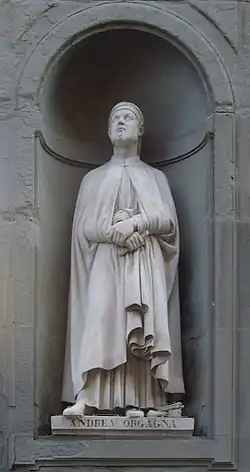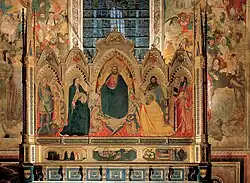Orcagna


Andrea di Cione di Arcangelo (c. 1308 – 25 August 1368), better known as Orcagna, was an Italian painter, sculptor, and architect active in Florence. He worked as a consultant at the Florence Cathedral and supervised the construction of the façade at the Orvieto Cathedral.[1] The highly paid tabernacle for the Maestà by Bernardo Daddi at Orsanmichele (1349–59) was immediately praised.[2] His Strozzi Altarpiece (1354–57) is noted as defining a new role for Christ as a source of Catholic doctrine and papal authority.[3][4]
Works
Orcagna's works include:
- Fresco of Saint Anne calling the citizens of Florence to arms against the tyrant Walter of Brienne, Duke of Athens, formerly in the Stinche Prison (c. 1343), a huge circular painting with a truthful depiction of the Palazzo Vecchio, where it is today
- Altarpiece of the Redeemer (1354–57) in the Strozzi di Mantova Chapel at Santa Maria Novella, Florence
- The tabernacle in Orsanmichele (1352–59)
- The mosaic decoration and the design for the rose window of the cathedral of Orvieto is attributed to Orcagna, who had become Master of the Works in 1359.
- His fresco of the Crucifixion with a multitude of angels surrounding the cross, portrayed on a dark background and a few fragments of the Last Supper (1365).[5]
Pupils
Among Orcagna's pupils and legacy were:
- Nello di Vanni, a Pisan painter of the 14th century, who also worked for the Campo Santo. Nello di Vanni is conjectured to be identical with Bernardo Nello or Giovanni Falcone.[6]
- Tommaso del Mazza, called Tomasso di Marco by Giorgio Vasari.[7]
- Jacopo di Cione, brother of Andrea and mainly sculptor and architect.[8]
References
- ^ "Uffizi Gallery". Museumsinflorence.com.
- ^ Wolfgang Braunfels (1966) [1953]. Mittelalterliche Stadtbaukunst in der Toskana (in German) (3 ed.). Berlin: Gebrüder Mann. pp. 212 f.
- ^ Millard Meiss (1978) [1951]. "I. The New Form and Content: Orcagna's Altarpiece". Painting in Florence and Siena after the Black Death. The Arts, Religion, and Society in the Mid-Fourteenth Century (4 ed.). Princeton (NJ): Princeton University Press. pp. 9 ff. ISBN 0-691-00312-2.
- ^ Eimerl, Sarel (1967). The World of Giotto: c. 1267–1337. et al. Time-Life Books. p. 187. ISBN 0-900658-15-0.
- ^ "Cenacolo by Andrea". www.visitflorence.com.
- ^ Bryan, Michael (1889). Walter Armstrong; Robert Edmund Graves (eds.). Dictionary of Painters and Engravers, Biographical and Critical. Vol. II L-Z. London: George Bell and Sons. p. 586.
- ^ Gaetano Milanesi, ed. (1906) [1878]. Le vite de' più eccellenti pittori, scultori ed architettori scritte da Giorgio Vasari. Volume 1. Florence: G. C. Sansoni. p. 609.
- ^ Vasari/Milanesi 1906, p. 610.
External links
Wikimedia Commons has media related to Andrea Orcagna.
- Middleton, John Henry (1911). . In Chisholm, Hugh (ed.). Encyclopædia Britannica. Vol. 20 (11th ed.). Cambridge University Press. pp. 165–167.